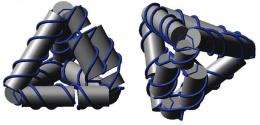September 8, 2009 feature
Scientists Build Nanostructures out of Single DNA Strands

(�鶹��ԺOrg.com) -- With its unique double-helical structure, DNA has the ability to be used as a programmable building material to construct designer nanoscale architectures. Complex DNA architectures could have a variety of applications, from DNA-based nanomotors to biosensing and drug delivery. Taking the research a step forward, researchers have recently constructed a nanometer-sized tetrahedron from a single strand of DNA, using a method that could have advantages for assembling similar structures on a large scale.
The researchers, from Arizona State University (ASU) and the Hong Kong University of Science and Technology (HKUST), have published their results in a recent issue of the Journal of the American Chemical Society.
As the researchers explain, the variety of different artificial DNA constructions has been increasing. So far, 3D DNA nanostructures are made from multiple DNA strands (oligonucleotides) with deliberately designed sequences. In this new study, Hao Yan of ASU, Yongli Mi of HKUST, and their colleagues have shown that DNA tetrahedrons can now be self-folded from only a single DNA strand. In addition, they demonstrated a method to replicate the DNA tetrahedrons in vivo, which could also be applied to the design and replication of other DNA nanostructures in the future.
“A self-folded 3D nanocage that can be replicated in vivo tells us how powerful nature's machineries are,” Yan and Mi told �鶹��ԺOrg.com. “DNA nanostructures can serve as scaffolds to organize other material with controlled spatial arrangement. Spatial dependent biomolecular/nanomaterial interactions can thus be tuned and studied.”
The DNA tetrahedrons, made of four triangular faces, were constructed from a DNA strand that was 286 nucleotides long. The tetrahedron’s six edges were composed of double helices: five were identical (double helical), while the sixth edge had a more complex “twin double-helical” structure. Four of the edges contained a cleavable site in the center, and all four vertices consisted of an unpaired thymine base to allow adequate flexibility for folding at these corners. Once the DNA strand was paired in this way, the researchers annealed the DNA in a process of heating and then cooling. When annealed, the DNA strand self-assembled into the seven-nanometer-long tetrahedron shape by combining the appropriate base pairs together.
After confirming the successful assembly of the DNA tetrahedron, the researchers then developed a method to replicate the nanostructures using in vivo cloning in order to produce the nanostructures on a large scale. The researchers inserted one of the tetrahedrons into a cloning molecule called a phagemid, and then recovered several replicated tetrahedrons through a process of restriction digestion of the phagemid. This method is fully scalable, with the yield of cloned structures proportional to the size of the culture medium.
As the researchers explain, using only a single DNA strand for creating nanostructures has several advantages, including simplifying the assembly process, increasing yield, offering the ability to scale up production, and creating structures with longer life spans in biological systems, such as inside living cells. This property is especially appealing for in vivo applications such as biosensing and drug delivery. In the future, the researchers hope to build on this method to synthesize nanostructures out of RNA, as well as build other complex shapes.
More information: Zhe Li, Bryan Wei, Jeanette Nangreave, Chenxiang Lin, Yan Liu, Yongli Mi, and Hao Yan. “A Replicable Tetrahedral Nanostructure Self-Assembled from a Single DNA Strand.” J. Am. Chem. Soc.
Copyright 2009 �鶹��ԺOrg.com.
All rights reserved. This material may not be published, broadcast, rewritten or redistributed in whole or part without the express written permission of �鶹��ԺOrg.com.
















